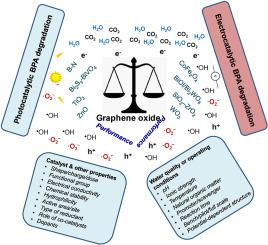当前位置:
X-MOL 学术
›
Chemosphere
›
论文详情
Our official English website, www.x-mol.net, welcomes your
feedback! (Note: you will need to create a separate account there.)
Photocatalytic and electrocatalytic degradation of bisphenol A in the presence of graphene/graphene oxide-based nanocatalysts: A review
Chemosphere ( IF 8.1 ) Pub Date : 2024-04-06 , DOI: 10.1016/j.chemosphere.2024.141941 Byung-Moon Jun 1 , Seong-Nam Nam 2 , Bongyeon Jung 3 , Jong Soo Choi 3 , Chang Min Park 4 , Choe Earn Choong 5 , Min Jang 5 , Eun Hea Jho 6 , Ahjeong Son 3 , Yeomin Yoon 3
Chemosphere ( IF 8.1 ) Pub Date : 2024-04-06 , DOI: 10.1016/j.chemosphere.2024.141941 Byung-Moon Jun 1 , Seong-Nam Nam 2 , Bongyeon Jung 3 , Jong Soo Choi 3 , Chang Min Park 4 , Choe Earn Choong 5 , Min Jang 5 , Eun Hea Jho 6 , Ahjeong Son 3 , Yeomin Yoon 3
Affiliation

|
Bisphenol A (BPA), a widely recognized endocrine disrupting compound, has been discovered in drinking water sources/finished water and domestic wastewater influent/effluent. Numerous studies have shown photocatalytic and electrocatalytic oxidation to be very effective for the removal of BPA, particularly in the addition of graphene/graphene oxide (GO)-based nanocatalysts. Nevertheless, the photocatalytic and electrocatalytic degradation of BPA in aqueous solutions has not been reviewed. Therefore, this review gives a comprehensive understanding of BPA degradation during photo-/electro-catalytic activity in the presence of graphene/GO-based nanocatalysts. Herein, this review evaluated the main photo-/electro-catalytic degradation mechanisms and pathways for BPA removal under various water quality/chemistry conditions (pH, background ions, natural organic matter, promotors, and scavengers), the physicochemical characteristics of various graphene/GO-based nanocatalysts, and various operating conditions (voltage and current). Additionally, the reusability/stability of graphene/GO-based nanocatalysts, hybrid systems combined with ozone/ultrasonic/Fenton oxidation, and prospective research areas are briefly described.
中文翻译:

石墨烯/氧化石墨烯纳米催化剂存在下双酚 A 的光催化和电催化降解:综述
双酚 A (BPA) 是一种广泛认可的内分泌干扰化合物,已在饮用水源/成品水和生活废水进水/废水中被发现。大量研究表明,光催化和电催化氧化对于去除 BPA 非常有效,特别是在添加石墨烯/氧化石墨烯 (GO) 基纳米催化剂时。然而,水溶液中 BPA 的光催化和电催化降解尚未得到综述。因此,本综述全面了解了石墨烯/GO 纳米催化剂存在下的光/电催化活性中的 BPA 降解。在此,本综述评估了在各种水质/化学条件(pH、背景离子、天然有机物、促进剂和清除剂)下去除 BPA 的主要光/电催化降解机制和途径,以及各种石墨烯/石墨烯的物理化学特性。基于 GO 的纳米催化剂,以及各种操作条件(电压和电流)。此外,还简要描述了石墨烯/GO基纳米催化剂的可重复使用性/稳定性、与臭氧/超声波/芬顿氧化相结合的混合系统以及前瞻性研究领域。
更新日期:2024-04-06
中文翻译:

石墨烯/氧化石墨烯纳米催化剂存在下双酚 A 的光催化和电催化降解:综述
双酚 A (BPA) 是一种广泛认可的内分泌干扰化合物,已在饮用水源/成品水和生活废水进水/废水中被发现。大量研究表明,光催化和电催化氧化对于去除 BPA 非常有效,特别是在添加石墨烯/氧化石墨烯 (GO) 基纳米催化剂时。然而,水溶液中 BPA 的光催化和电催化降解尚未得到综述。因此,本综述全面了解了石墨烯/GO 纳米催化剂存在下的光/电催化活性中的 BPA 降解。在此,本综述评估了在各种水质/化学条件(pH、背景离子、天然有机物、促进剂和清除剂)下去除 BPA 的主要光/电催化降解机制和途径,以及各种石墨烯/石墨烯的物理化学特性。基于 GO 的纳米催化剂,以及各种操作条件(电压和电流)。此外,还简要描述了石墨烯/GO基纳米催化剂的可重复使用性/稳定性、与臭氧/超声波/芬顿氧化相结合的混合系统以及前瞻性研究领域。




















































 京公网安备 11010802027423号
京公网安备 11010802027423号